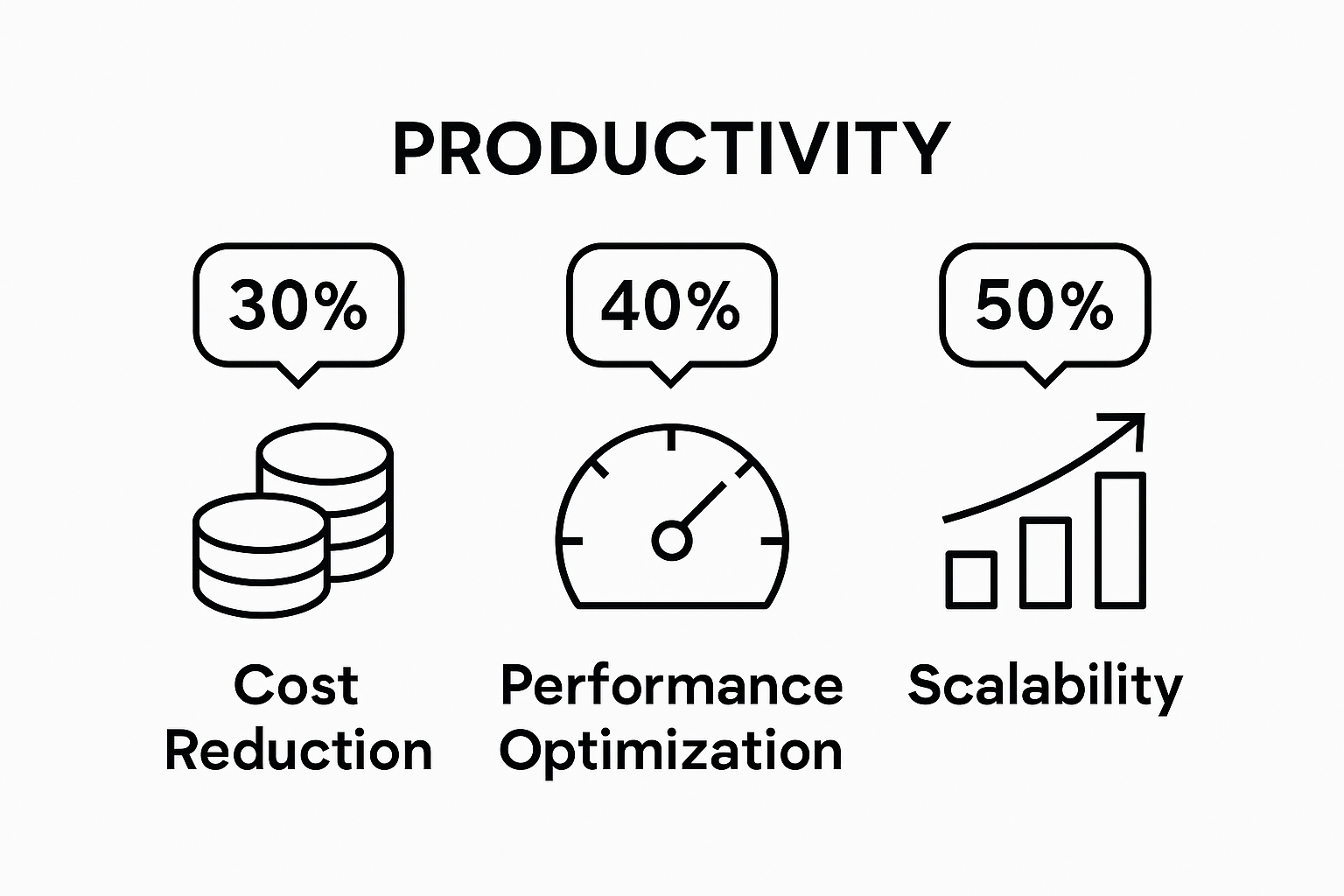
Tech runs the world of work now. One number says it all: jobs needing strong digital skills jumped from 45 percent to 71 percent between 2002 and 2016. Surprised? Most people think of technology as just another tool in the office drawer. But it is not about gadgets or busywork. Tech is reshaping what productivity even means, and the real story is just beginning.
Table of Contents
- What Is The Role Of Tech In Productivity?
- Why Technology Matters For Productivity Improvement
- How Technology Enhances Collaboration And Communication
- Key Tools And Technologies Driving Productivity
- Real-World Examples Of Tech Transforming Productivity
Quick Summary
| Takeaway | Explanation |
|---|---|
| Automation enhances efficiency | Automating routine tasks allows employees to focus on strategic work, significantly boosting overall productivity. |
| Real-time collaboration tools are essential | Cloud-based platforms facilitate seamless communication, enabling teams to work together effectively across distances. |
| Data-driven decisions improve outcomes | Advanced analytics provide insights that help professionals make informed decisions quickly, enhancing operational effectiveness. |
| Technology reduces cognitive load | Intelligent systems simplify complex processes, allowing workers to concentrate on higher-value tasks and innovation. |
| Effective tech integration drives growth | Successful incorporation of technology not only streamlines workflows but also fosters an environment of continuous improvement and performance enhancement. |
What is the Role of Tech in Productivity?
Technology has fundamentally transformed how we work, communicate, and achieve goals. At its core, tech serves as a powerful multiplier for human capabilities, enabling individuals and organizations to accomplish more with less effort and time.
Understanding Technology’s Productivity Mechanisms
Productivity through technology occurs by automating repetitive tasks, streamlining complex workflows, and providing intelligent tools that enhance human performance. Research from the Brookings Institution highlights that digital technologies can dramatically boost productivity when strategically implemented.
Key productivity enhancement mechanisms include:
- Automation of Routine Tasks: Software and AI systems can handle repetitive administrative work, freeing human talent for strategic thinking.
- Real-Time Collaboration Tools: Cloud-based platforms enable seamless communication and project management across geographical boundaries.
- Data Analysis and Decision Support: Advanced analytics help professionals make faster, more informed decisions.
Technological Tools Driving Productivity
Modern technology offers an array of tools designed to optimize work processes. From project management software to intelligent communication platforms, these technologies create environments where efficiency becomes the default mode of operation. Learn more about optimizing your digital workflow.
Understanding technology’s role in productivity requires recognizing it as more than just a set of tools. It represents a comprehensive approach to work that prioritizes efficiency, reduces cognitive load, and creates pathways for innovation. By leveraging the right technological solutions, professionals can transform potential into tangible results, making complex tasks more manageable and strategic objectives more achievable.
The table below summarizes the key technological tools discussed in the article and their primary roles in enhancing workplace productivity.
| Technology Tool | Main Function | Example Platforms |
|---|---|---|
| Project Management Software | Enables task tracking and team coordination | Asana, Trello |
| Cloud Collaboration Platforms | Supports seamless document sharing and real-time editing | Google Workspace, Microsoft 365 |
| Artificial Intelligence | Provides predictive insights and performance optimization | Machine learning analytics |
| Real-Time Communication Tools | Facilitates instant messaging and video conferencing | Slack, Zoom |
| Shared Workspace Solutions | Allows remote access and synchronous project management | Notion, Monday.com |
Why Technology Matters for Productivity Improvement
Technology has become a critical catalyst for productivity improvement across industries, transforming traditional work models and enabling unprecedented levels of efficiency. By providing intelligent solutions that address complex workflow challenges, technology empowers professionals to achieve more with significantly less effort.
The Economic Impact of Technological Innovation
According to research from the National Bureau of Economic Research, technological innovations directly influence organizational productivity by enabling more decentralized decision making and empowering workers. The economic implications are profound, as technology creates pathways for continuous improvement and strategic resource allocation.

Key economic benefits of technological productivity enhancement include:
- Cost Reduction: Automated systems minimize manual labor expenses
- Performance Optimization: Advanced analytics provide real-time insights for strategic decision making
- Scalability: Digital tools allow businesses to expand capabilities without proportional increases in human resources
Breaking Technological Barriers to Productivity
Modern technology addresses productivity limitations by creating smart, interconnected work environments. Cloud computing, artificial intelligence, and collaborative platforms eliminate traditional constraints of time and geography. Explore how remote work technologies are transforming professional landscapes.
Understanding technology’s role requires recognizing it as more than a mere tool. It represents a comprehensive ecosystem of solutions that continuously evolve to meet emerging professional challenges, enabling individuals and organizations to transcend previous performance limitations and unlock new potential for growth and innovation.
How Technology Enhances Collaboration and Communication
Technology has revolutionized how professionals interact, communicate, and collaborate across geographical boundaries. By breaking down traditional communication barriers, digital tools have transformed workplace dynamics, enabling seamless and instantaneous information exchange.
Digital Platforms Redefining Teamwork
According to research from the National Academies Press, communication technologies like videoconferencing, shared digital workspaces, and real-time messaging platforms have fundamentally altered collaborative processes. These tools enable teams to work synchronously and asynchronously, transcending physical limitations and time zones.
Key technological collaboration features include:
- Real-Time Communication: Instant messaging and video conferencing platforms
- Shared Workspace Solutions: Cloud-based document editing and project management tools
- Global Connectivity: Seamless international team collaboration capabilities
Transforming Communication Infrastructures
Modern communication technologies create intelligent, interconnected work environments that facilitate faster decision making and knowledge sharing. Check out our guide on transitioning to remote work strategies to understand how these technologies are reshaping professional interactions.
Beyond mere communication, these technologies represent a comprehensive ecosystem that empowers teams to collaborate more effectively. By providing intuitive, user-friendly platforms that integrate multiple communication channels, technology enables professionals to work more cohesively, share insights rapidly, and maintain high levels of engagement regardless of physical distance.
Key Tools and Technologies Driving Productivity
In the rapidly evolving digital landscape, specific technological tools have emerged as powerful catalysts for enhancing workplace efficiency and performance. These technologies go beyond simple automation, providing intelligent solutions that transform how professionals approach complex tasks and strategic objectives.
Intelligent Productivity Platforms
According to research from the Organisation for Economic Co-operation and Development, strategic investment in technological tools can significantly boost organizational productivity. Modern productivity platforms integrate multiple functionalities, creating comprehensive ecosystems that streamline workflow and decision making.
Critical productivity technologies include:
- Project Management Software: Tools like Asana and Trello that enable task tracking and team coordination
- Cloud Collaboration Platforms: Google Workspace and Microsoft 365 for seamless document sharing and real-time editing
- Artificial Intelligence Analytics: Machine learning systems that provide predictive insights and performance optimization
Emerging Technologies Transforming Work
Advanced technologies are rapidly reshaping professional environments, offering unprecedented capabilities for efficiency and innovation. Artificial intelligence, machine learning, and automation technologies are no longer futuristic concepts but practical tools that enable professionals to focus on high-value strategic work.
The most effective productivity technologies share a common characteristic: they augment human capabilities rather than simply replacing them. By providing intelligent assistance, reducing cognitive load, and enabling more strategic thinking, these tools represent a new paradigm of technological empowerment that goes far beyond traditional productivity metrics.
Real-World Examples of Tech Transforming Productivity
Technology has revolutionized productivity across diverse industries, demonstrating remarkable capabilities to streamline processes, reduce inefficiencies, and unlock unprecedented levels of performance. By integrating intelligent solutions, organizations are witnessing transformative changes that extend far beyond traditional workflow improvements.
This table illustrates how technology has transformed productivity within key professional sectors, as highlighted by the article.
| Industry Sector | Technology Application | Productivity Impact |
|---|---|---|
| Healthcare | Telemedicine platforms | Enables remote consultations and patient monitoring |
| Education | Interactive digital learning tools | Increases student engagement and knowledge retention |
| Government Services | Web applications for process automation | Streamlines bureaucracy and reduces administrative tasks |
Digital Transformation in Professional Sectors
According to research highlighting workforce digitalization, digital technologies have dramatically reshaped professional landscapes. Between 2002 and 2016, jobs requiring substantial digital knowledge escalated from 45% to 71%, reflecting technology’s profound impact on workforce capabilities.
Pivotal technology implementation examples include:
- Healthcare: Telemedicine platforms enabling remote consultations and patient monitoring
- Education: Interactive digital learning tools enhancing student engagement and knowledge retention
- Government Services: Web applications streamlining bureaucratic processes and reducing administrative overhead
Innovative Technological Interventions
Beyond sector-specific applications, technology demonstrates remarkable potential in solving complex organizational challenges. Intelligent systems now provide predictive analytics, automate repetitive tasks, and create adaptive workflows that respond dynamically to changing business environments.
The most compelling productivity transformations occur when technology is strategically integrated, not as a replacement for human expertise, but as an empowering tool that amplifies human potential. By reducing cognitive load, providing real-time insights, and enabling more strategic decision making, these technological interventions represent a fundamental reimagining of work itself.

Unlock Peak Productivity On the Move
Are you frustrated by wasted time and clunky tools holding back your productivity? The article showed how technology should empower you to streamline workflows, collaborate in real time, and conquer tasks anywhere you land. But in reality, common challenges like unreliable gear, heavy bags, and tangled cables can keep you from working your best. At Store 42, we bridge that gap with solutions made for modern creators, freelancers, and on-the-go professionals who want to maximize efficiency and flexibility without sacrificing style.

Ready to experience true freedom and power in your workflow? Equip yourself with ultra-portable chargers, noise-canceling headphones, and travel-friendly apparel trusted by digital nomads and remote workers everywhere. Discover how our curated gear at Store 42 supports your goals to automate, collaborate, and produce at your best. Shop now and see how the right tools can transform your productivity today.
Frequently Asked Questions
What is the main role of technology in productivity?
Technology acts as a powerful multiplier for human capabilities, allowing individuals and organizations to achieve more with less effort and time by automating tasks, streamlining workflows, and enhancing performance.
How does technology enhance collaboration in the workplace?
Technology provides tools like real-time communication platforms, cloud collaboration software, and shared workspaces, which enable teams to collaborate effectively regardless of geographic location or time zone.
What are some key technological tools that improve productivity?
Key tools include project management software (like Asana and Trello), cloud collaboration platforms (such as Google Workspace and Microsoft 365), and artificial intelligence analytics that provide insights for better decision-making.
Why is automation important for productivity?
Automation is critical as it minimizes the time spent on repetitive tasks, allowing professionals to focus on more strategic, high-value work that contributes to overall organizational efficiency.

